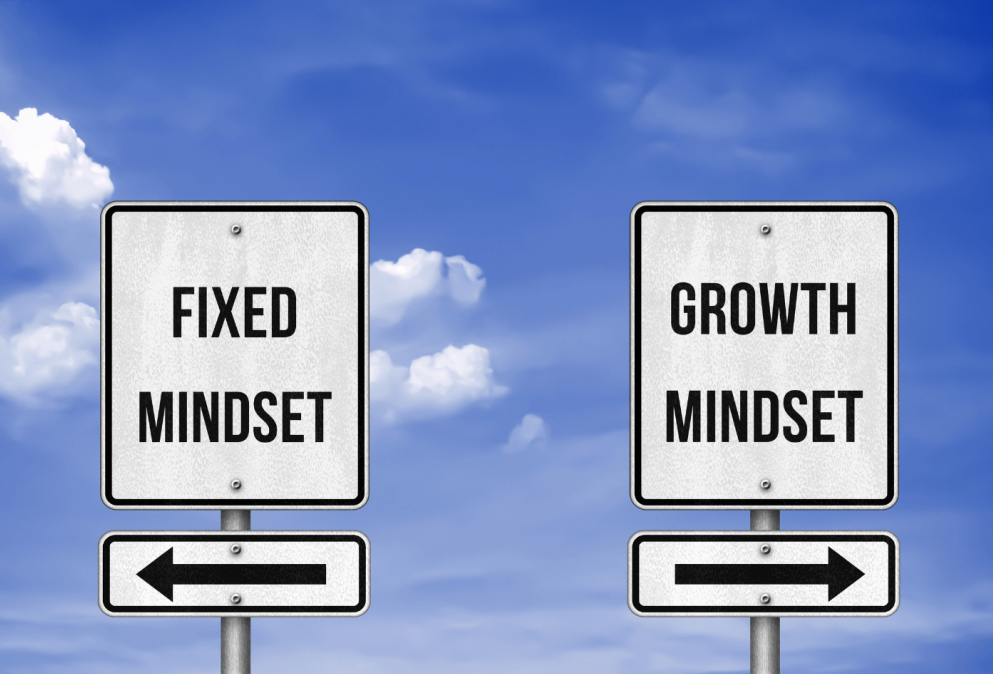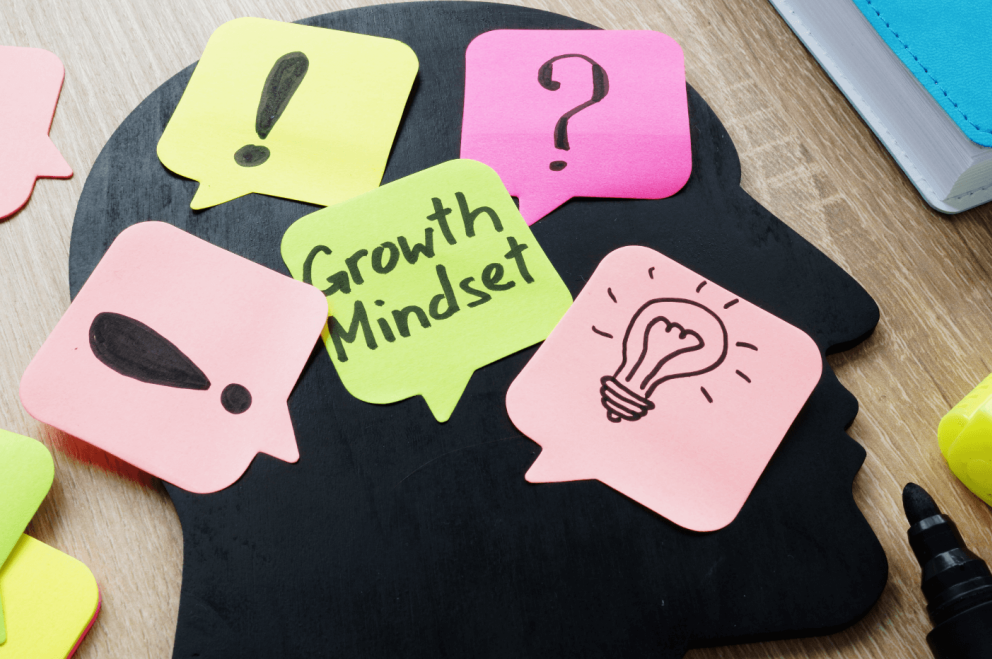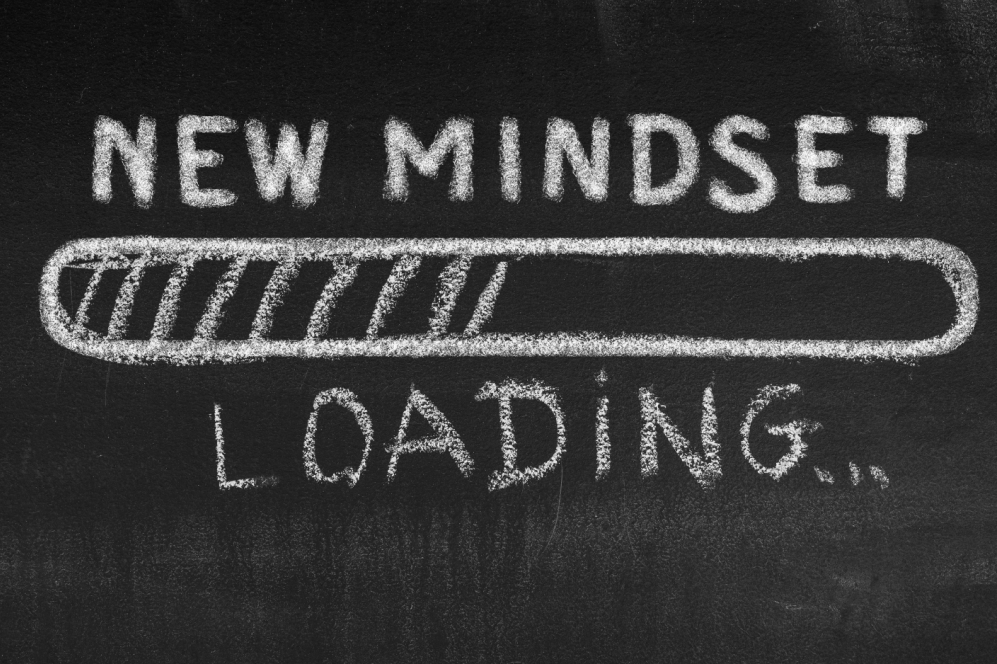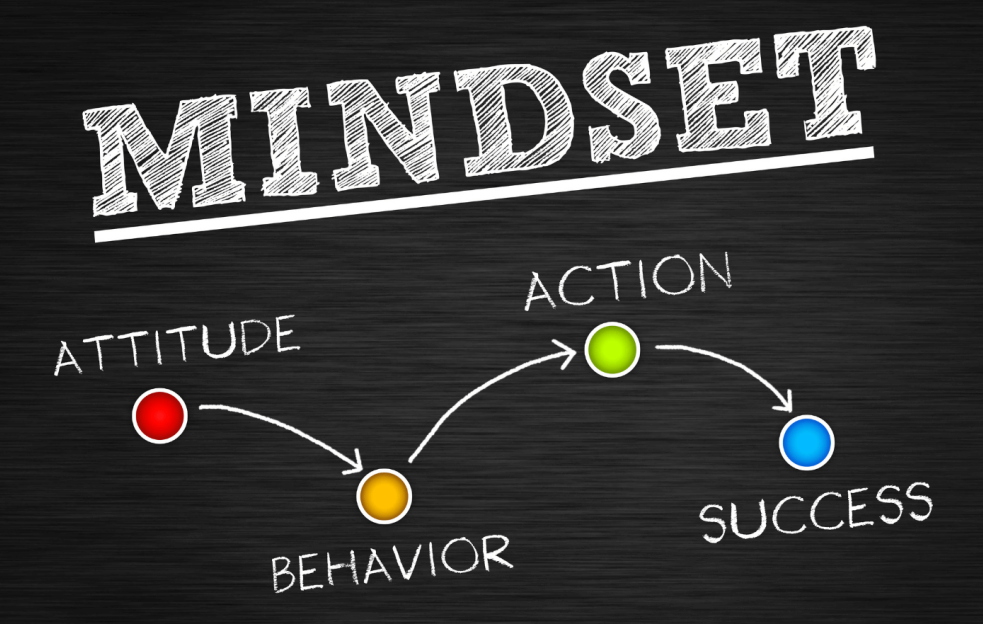
Your mindset is the internal lens through which you see the world and yourself. It’s not just about thoughts. It’s how you interpret struggle, success, and your own potential. It shapes how you respond when life throws curveballs at you, how you set your goals, and whether you get back up after failure or retreat.
If you believe you’re stuck with what you’ve got – your intelligence, your personality, your skills – then every challenge feels like a test you’re either destined to pass or fail. That’s what’s known as a fixed mindset, and it slowly kills most progress.
But with a growth mindset, you turn this around. You’re saying, “I can get better. I can learn. I’m not finished.”
And no, this isn’t just wishful thinking. It’s a mindset rooted in science. Your brain is built to adapt, change, and rewire itself with effort and repetition (this is what’s known as neuroplasticity). That means you’re not locked into your past. You’re wired for growth.
And more importantly, a growth mindset isn’t some rare trait that you’re either born with or without. It’s not a genetic trait, but a skill. And like any skill, you can train it, just like a muscle. Every time you challenge a limiting belief, push through failure, or choose effort over excuses, you strengthen it.
Growth isn’t a personality type. It’s a decision. One you make daily.
“It’s not that I’m so smart, it’s just that I stay with problems longer.”
– Albert Einstein
What Is a Growth Mindset?

A growth mindset is the belief that your intelligence, skills, and abilities aren’t fixed – they can grow. With the right effort, smart strategies, and a willingness to learn, you can evolve far beyond where you started.
Psychologist Carol Dweck, who pioneered the concept, introduced this idea by contrasting it with the fixed mindset – the belief that talent is something you’re born with, and that no amount of work will really move the needle. People with a fixed mindset avoid challenges, fear failure, and often give up when things get tough. This is because deep down, they think effort is pointless if you’re “not naturally good.”
But with a growth mindset, the rules change. Failure isn’t final – it’s fuel and information. Instead of letting mistakes define you, you use them. Instead of fearing struggle, you lean into it. Effort no longer feels like a punishment and starts looking like the path forward. You stop needing to prove yourself and start focusing on improving yourself.
Over time, this shift makes you more resilient, curious, and adaptable. You bounce back faster. You ask better questions. You take smarter risks. And most importantly, you stop living in fear of your limits, because you no longer see them as permanent.
“Why waste time proving over and over how great you are, when you could be getting better?”
– Carol Dweck
What Are the 5 Characteristics of a Growth Mindset?

Developing a growth mindset is a transformative journey that changes how you approach challenges, setbacks, and personal development. According to Carol Dweck, a growth mindset is built on a few key internal beliefs and traits that shape how you see yourself and the world.
Here are five core characteristics of someone with a growth mindset:
1. Openness to Challenges
Growth-minded individuals don’t avoid difficult situations – they actively seek them out. They see every challenge as a chance to learn, improve, and test their current limits. Instead of being paralyzed by fear of failure, they view discomfort as a sign of growth.
2. Resilience in the Face of Setbacks
When things go wrong, people with a growth mindset don’t give up. They analyze what happened, learn from their mistakes, and try again with a new strategy. Setbacks are not dead ends – they’re detours toward progress.
3. Belief in Effort and Persistence
A defining trait of a growth mindset is the belief that effort leads to improvement. Success isn’t about instant results or natural talent – it’s about sticking with the process and showing up, even on the hard days.
4. Appreciation of Others’ Success
Rather than being threatened or discouraged by others’ achievements, those with a growth mindset feel inspired. They see others’ success as proof that growth is possible and use it as motivation to keep going.
5. Focus on Progress, Not Perfection
People with a growth mindset don’t expect to be perfect. They aim to improve. They celebrate small wins and see each step forward as meaningful. Even when progress is slow, they value the journey over the destination.
These five characteristics define the mindset, but how do you actually build and strengthen them over time?
Let’s look at some practical steps you can take to develop a growth mindset that sticks for life.
“Live as if you were to die tomorrow. Learn as if you were to live forever.”
– Mahatma Gandhi
How Do You Develop a Growth Mindset For Life?

So, as you can see, developing a growth mindset isn’t just about positive thinking.
It’s about rewiring how you see yourself and your potential over the long haul, and
cultivating a belief that talents and abilities can be developed through effort, learning, and persistence.
But how do you actually build that mindset and make it stick for life.
Here’s how to start cultivating a growth mindset that lasts:
1. Understand the Difference Between a Fixed and Growth Mindset
Before you can change your mindset, you need to recognize which one you’re operating from. A fixed mindset believes your intelligence, talents, and personality traits are set in stone. A growth mindset, on the other hand, sees these traits as adaptable and improvable.
Ask yourself: Do you avoid challenges or fear failure? Do you feel threatened by others’ success? If so, you might be holding onto fixed beliefs. Awareness is the first step toward transformation, so spending some time looking at your beliefs before you start taking action is time well spent.

Personally, I think writing is one of the best tools for this. The act of putting pen to paper and working out your thoughts forces a much deeper level of clarity about what is actually going on in your mind.
2. Challenge Limiting Beliefs
Our inner dialogue shapes our reality. When you catch yourself thinking, “I’m just not good at this,” reframe it to, “I’m not good at this… yet.” Adding that one word shifts your focus from limitation to possibility.
Start identifying those mental roadblocks. Are you telling yourself you’re too old, too late, or not smart enough? Replace those limiting thoughts with growth-oriented affirmations like, “I can learn”, “I can get better at this”, “If I work at these things continuously, I will improve every day.”
3. Embrace Lifelong Learning
People with a growth mindset are curious learners. They ask questions, seek feedback, and explore new ideas without fear of looking “inexperienced.” Learning doesn’t end with school. It’s a continuous journey throughout life.
Whether it’s reading books, taking courses, or trying new skills, make learning a habit. Not only does this expand your abilities, it also reinforces the belief that you’re capable of growing in any area of life.
4. Normalize Struggle and Setbacks

Failure isn’t the opposite of success – it’s part of the process. When you encounter setbacks, don’t see them as signs to quit. See them as valuable lessons. Every misstep brings insight that moves you closer to understanding. In fact, setbacks are essential for learning and growing.
Some of the most successful people in the world – Oprah Winfrey, Michael Jordan, and J.K. Rowling, just to name a few, famously faced rejection and failure. What set them apart was their ability to learn, adapt, and keep going.
“Rock bottom became the solid foundation on which I rebuilt my life.”
— J.K. Rowling
5. Focus on Effort and Progress Over Perfection
A growth mindset values progress, not perfection. Instead of obsessing over outcomes, focus on the effort you’re putting in and the small wins you’re achieving along the way.
One of the most powerful mindset shifts you can make is praising effort over results. Tell yourself things like, “I’m proud of how hard I worked today,” or “I made progress, even if it wasn’t perfect.” Over time, this creates more resilience and motivation.
In one of her most influential studies, Carol Dweck and her team at Stanford University conducted an experiment involving over 400 fifth-grade students across the United States. The children were given a series of puzzles. A relatively easy one at first, followed by more difficult problems. After completing the first puzzle, each child was randomly given one of two types of praise:
- One group was praised for their intelligence (“You must be very smart.”),
- The other group was praised for their effort (“You must have worked really hard.“).
The results were striking:
Children who were praised for their intelligence were more likely to choose easier tasks later, avoiding challenges that might threaten their “smart” label. In contrast, those praised for effort chose harder tasks, showed greater resilience when faced with failure, and ultimately performed better in follow-up tests.
This study revealed a key insight:
➡️ Praising effort fosters a growth mindset, while praising innate ability reinforces a fixed mindset.
Dweck’s findings showed that how we speak to ourselves and others – especially around success – can either encourage a lifelong love of learning or create a fear of failure.
“Test scores and measures of achievement tell you where a student is, but they don’t tell you where a student could end up.”
– Carol Dweck
6. Surround Yourself with a Growth-Oriented Environment
Your environment plays a huge role in shaping your mindset. Spend time with people who support your growth, challenge your thinking, and encourage you to keep improving. These could be mentors, coaches, friends, or online communities.
And more importantly, be very mindful of how much time you spend with people or content that fosters comparison, negativity, or defeatist thinking. Choose inspirational content in your life and your circle.

Perhaps you need to do a little inventory of how you spend your time, your energy, and your attention? Do you really need to watch the news every day? Is it beneficial to follow along in the latest intrigues of the Kardashians? What kind of conversations are you having with the people you spend the most time with?
7. Celebrate Small Wins and Reflect Often
Progress isn’t always loud or obvious, but it’s always worth celebrating. Whether it’s journaling your growth, noting what you learned this week, or simply acknowledging an uncomfortable step you took towards something new, these moments build momentum – notice them and enjoy them.
Reflection helps reinforce your mindset. Ask yourself: “What did I try today?” “What did I learn?” “How did I grow?” Consistent reflection helps keep your focus on learning and evolving.
Continuous Evolving
A growth mindset isn’t something you “achieve” once. It’s something you cultivate daily. By committing to self-awareness, curiosity, resilience, and effort, you begin to live with the belief that you are always evolving.
Start today by picking one small shift to make. Maybe it’s catching a negative thought and reframing it. Maybe it’s choosing to learn from a mistake instead of criticizing yourself. The more you practice, the more natural it becomes to practice growth thinking, and over time, it transforms your entire life.
You simply start building a habit of deliberately choosing more constructive thoughts. It’s actually not that complicated. (You can learn a lot more about how to build habits HERE. )
“I am always doing that which I cannot do, in order that I may learn how to do it.”
– Pablo Picasso
How to Teach Growth Mindset to Adults

Kids aren’t the only ones who can learn how to grow – we all can. But teaching a growth mindset to adults requires a different approach. Adults often carry years of ingrained beliefs, fear of failure, and a tendency to protect their self-image. That’s why your strategy needs to be rooted in empathy, real-life relevance, and psychological safety.
Here’s how to guide adults into a growth mindset:
Lead by Example
The most powerful way to teach a growth mindset is to live it out loud.
Talk openly about your own mistakes, setbacks, and the lessons you’ve learned along the way. When adults see that you’re not afraid to stumble, and that you bounce back stronger, they’re more likely to give themselves permission to do the same.
Vulnerability creates connection, and modeling resilience invites others to adopt it too.
“People would rather follow someone who is always real than someone who is always right.”
– Craig Groeschel
Share Real-Life Stories
Don’t preach, tell stories instead.
We remember stories long after we forget bullet points or advice. Share examples of people (famous or personal) who failed, adapted, and kept going. Let the story do the teaching. It bypasses resistance and makes the lesson feel tangible, not theoretical.

Here are some real-world examples that most people could relate to:
J.K. Rowling faced poverty and was rejected by 12 publishers before Harry Potter became a global phenomenon. She was told her story wouldn’t sell, but she kept going. Her persistence turned rejection into record-breaking success.
Michael Jordan was cut from his high school basketball team, but instead of quitting, he practiced harder. He later said, “I’ve failed over and over again in my life, and that is why I succeed.” His setbacks became fuel for greatness.
Sara Blakely, founder of Spanx, had no business background and was rejected by investors, but she kept pitching. Her father encouraged her to embrace failure daily. That mindset helped her build a billion-dollar company from scratch.
Create Psychological Safety

Adults often hide behind competence. They fear looking incapable, especially in group or professional settings. To encourage a growth mindset, it’s important to create a culture where it’s safe to fail, which could look like this:
- Encouraging experimentation
- Rewarding effort and curiosity, not just results
- Reframing failure as feedback
Growth needs breathing room. When people know they won’t be judged for trying something new (and messing up), they’ll take more risks. And this means learning more deeply.
Use Reflection Tools
Adults process change best through introspection. While children often learn by trial and error, adults gain the most from reflecting on their thoughts, behaviors, and experiences. With years of ingrained beliefs, real transformation usually starts with self-awareness. Asking reflective questions like “What did I learn?” or “What could I do differently next time?” helps shift them from autopilot to intentional growth.
Reflection tools, such as journaling prompts, weekly check-ins, group discussions, or one-on-one coaching, create the space needed to notice patterns and track progress. Even simple prompts like “What challenge did I face this week, and what did I learn from it?” can lead to major mindset shifts over time.

“He who opens a school door, closes a prison.”
– Victor Hugo
Encourage the Small Wins
Mindset doesn’t flip overnight. It shifts slowly, moment by moment. Acknowledge small wins, like someone asking for help, rephrasing self-doubt, or pushing through a difficult task. These micro-milestones matter. When people feel their effort is noticed, they’re more likely to stay on the path of growth.
Teaching adults a growth mindset isn’t about adding pressure. It’s about removing fear. When you lead with compassion, model the process, and create a safe space to learn, people can move from simply hearing the message to actually embodying it. And that’s where real change is possible. This goes for everybody, but is especially important in adults.
“You are always a student, never a master. You have to keep moving forward.”
– Conrad Hall
Final Thoughts: Growth Is a Choice

One of the things that I’ve noticed in my years as a counselor in mental health is that, almost no matter how unhappy people are with their circumstances, most people don’t go through significant change and start growing until they’re forced to by some sort of life crisis.
But it doesn’t have to be this way. You don’t need a life crisis to begin changing and growing. You don’t need a perfect plan. Growth begins the moment you decide to see yourself as not fixed, but evolving.
–> You don’t need to be perfect. You just need to be persistent enough to keep showing up. –> You don’t need to be fearless. You just need to be willing to try, even when it’s uncomfortable.
–> You don’t need to know exactly where it leads. Just take the next step with intention.
A growth mindset is less about radical change and more about small, consistent shifts in how you view your challenges, your potential, and your future. It’s about replacing “I can’t” with “I can learn,” and choosing to believe in the progress, even when it’s slow.
Every day, you have a choice to stay where you are or start stretching into something new, focusing on who you’re becoming rather than who you are.
Choose growth. Every time you do, you strengthen that mindset. And after a while, it becomes your natural way of being.
And that, my friend, is a VERY fulfilling way to live your life.
“Your mindset determines how you see the world, and how you see the world determines your success.”
– Arianna Huffington

Let’s Hear From You
What’s one belief you’re ready to shift today?
Drop a comment below and share how you’re applying a growth mindset in your life right now, or how you’d like to…
Big or small, your story could inspire someone else who’s just getting started. Let’s learn, grow, and rise together.
What an empowering and deeply insightful guide to developing a growth mindset not just as a concept, but as a lifelong practice. The article does a fantastic job explaining how mindset shapes everything from how we process failure to how we interpret success. I especially appreciated the deep dive into Carol Dweck’s study on praise and its impact on learning behavior it’s such a powerful illustration of how language can either reinforce limitations or unlock resilience. It raises two important questions: How can we apply this same principle of effort-focused praise in the workplace to foster stronger teams? And what daily rituals can we adopt to consistently reframe limiting thoughts?
The emphasis on reflection and self-awareness as tools for transformation resonated with me. It’s refreshing to see practical strategies like journaling, embracing discomfort, and celebrating small wins. This article doesn’t just explain a growth mindset it models it, encourages it, and makes it feel truly accessible to anyone ready to change.
Thank you so much for your kind words and thoughtful reflections — I truly appreciate you taking the time to engage so deeply with the article!
You raise two fantastic questions. When it comes to applying effort-focused praise in the workplace, one powerful approach is to recognize how team members approached a challenge, not just the outcome. For example, acknowledging perseverance, collaboration, or creativity during a tough project reinforces growth without making success feel like a fixed trait. Saying things like, “I really admire how you stuck with that problem and tried multiple angles to solve it,” can go a long way in cultivating a culture of resilience and continuous improvement.
As for daily rituals to reframe limiting thoughts — great question. A few that work well include:
Daily check-ins or journaling, especially with prompts like “What did I learn today?” or “What challenge helped me grow?”
Reframing statements (e.g., turning “I can’t do this” into “I can’t do this yet”).
Mindful pause-and-redirect moments, where you catch a limiting belief and intentionally swap it for a growth-oriented one.
Celebrating progress, even if it’s just recognizing effort on hard days.
Growth mindset really is a practice, and your comment models that beautifully. Thank you again for the thoughtful engagement — it means a lot!
Wow! This is a very powerful and practical guide for anyone ready to stop being held back by fear, perfectionism, or past limitations. It explains that your mindset ( yours alone ) is the way you interpret challenges and success—directly shaping your progress in life. Only when we step back and be open to understanding that our mindset builds the belief that can develop our abilities through effort and learning, which can lead to more resilience, better problem-solving, and stronger motivation. This is beneficial because it shifts the focus from fearing failure to seeing mistakes as stepping stones toward personal growth, making it especially relevant for adults navigating career shifts, creative blocks, or personal development goals. Something I am currently working through.
I think readers who want to change certain areas of their lives can start to work on their mindset as the foundation of success. It’s not an easy process believe me but worth the work to cultivate it. Your guides message can impact anyone ready to hear that they are the ones that can make meaningful change in their lives, especially adults who may have internalized fixed beliefs over time. This is important and essential for ongoing fulfilment. If you’ve ever felt stuck, uncertain, or “not good enough,” your article shows how to access a reset switch that’s both encouraging and actionable.
Thank you so much for your thoughtful and insightful comment! You’ve really captured the heart of what a growth mindset is all about — shifting from fear and self-doubt to possibility and progress.
I absolutely agree with you: mindset really is the lens through which we interpret our challenges and opportunities. And yes, it’s not an easy process, especially when we’ve spent years reinforcing limiting beliefs or avoiding failure out of fear. But like you said, it is worth the effort. Rewiring how we think, especially as adults, takes patience and compassion, but the rewards are immense: more resilience, confidence, and the freedom to keep evolving.
It sounds like you’re deep in the process of doing this work yourself, judging from your insights into the way these things unfold in real life. That level of self-awareness and willingness to grow is a major step, and yes, that transformation truly begins from the inside out. I hope the post offered you a sense of encouragement and clarity as you navigate your journey.
Thank you again for sharing your thoughts. I’ absolutely certain your words will resonate with others who are in the same boat, and serve as a powerful reminder that we all have the ability to reset, reframe, and rise.
Thanks again. All the best!
Michael
This was a truly refreshing read! I love how you unpacked the idea of a growth mindset in such a relatable way. It’s something I’ve been trying to cultivate myself, and your insights helped me recognize a few lingering limiting beliefs I hadn’t fully addressed. The part about viewing failure as feedback rather than a final outcome really struck a chord—it’s such a powerful shift in thinking. One question though: how do you recommend maintaining a growth mindset when you’re surrounded by people with a fixed mindset? Sometimes it feels like the real challenge isn’t just personal change, but also shielding that progress from external negativity. Thanks again for the valuable content—definitely bookmarking and sharing!
Thank you so much for your kind words. I’m really glad the post resonated with you, especially the part about failure as feedback. That shift has been a game-changer for me too, because it helps take the sting out of setbacks and turns them into stepping stones.
You brought up a great question, and one that’s very real: How do you maintain a growth mindset when you’re surrounded by people with a fixed mindset? It’s not easy, and I completely agree that the environment we surround ourselves with can either support our growth or challenge it.
What’s helped me most is simply being super protective about my mindset to the extent that I can. I really think in terms of mental fitness… Trying to constantly be aware of what I feed it, focusing on good things that reinforce growth: books, podcasts, journaling, affirmations, etc. And then I try to be mindful of what kind of energy people bring to the table, and try to spend the most time with those whose company I find energizing and constructive. But it’s hard sometimes! 😉 I also try to deliberately respond to fixed-mindset comments with curiosity rather than irritation. Sometimes, simply asking “what makes you think that?” can shift the tone or spark a deeper conversation.
But honestly, sometimes it’s about simply standing firm in your own beliefs, even when others don’t understand it. Just because someone else doubts growth doesn’t mean you have to. At the end of the day, we all have a choice of who we choose to spend our time with.
Thanks again for reading and sharing your thoughts! I appreciate any opportunity to take these conversations as far as possible. I’d love to know if there’s a limiting belief you’re working on reframing right now?
All the best!
Michael
The emphasis on shifting from a fixed to a growth mindset really resonates, especially the idea that challenges are opportunities rather than setbacks. How would you recommend someone maintain a growth mindset when they’re surrounded by people with limiting beliefs or toxic environments? Also, how can we measure progress in developing this mindset without falling into perfectionism or overanalyzing? The part about embracing failure is powerful, but in your experience, is there a point where failure becomes discouraging rather than educational?
Thanks so much for your comment, Slavisa. And you’re absolutely right, shifting to a growth mindset is powerful, but it’s definitely harder when you’re surrounded by people stuck in negativity or fixed beliefs.
When you’re in that kind of environment, I think it helps to think of your mental space like a sort of energy budget. You don’t have to cut people off entirely, but you can limit how much their mindset influences yours. Balance it out by feeding your brain with content and people that do support growth. This can be books, podcasts, or even online communities. These can make a big difference.
In terms of tracking your mindset progress without falling into perfectionism (which I totally relate to), I recommend looking for little signs of change rather than big wins. Like:
– Did I respond to that challenge a little better than I would have last year?
– Did I catch myself being self-critical and choose a kinder thought instead?
– Am I more willing to try again, even after something didn’t go well?
Those small moments make a big differecne, even if they don’t feel like it right away.
And about failure. Yes, 100%. It can get discouraging, especially if it feels like you’re hitting wall after wall. What’s helped me is just to keep reminding myself that failure isn’t the final result, it’s information. That doesn’t mean it won’t sting, but it does mean it feels less definite. Some days you need to step back and rest, other days you’ll have more energy to try again. It’s a process.
Thanks again for your questions. It’s clear that you’ve put some thought into this and are doing the work. That’s what matters the most.
All the best!
Michael
Thank you for this encouraging article —it resonated deeply with me. I work every day on shifting my inner voice from “I can’t” to “I can learn” and your suggestions—especially embracing challenges, prioritizing progress, and rewarding effort over results—feel practical and heartening.
I recently began journaling my small wins, like “I asked a question I feared sounded silly” or “I tried a new way to teach my child,” and it’s surprisingly powerful. It reminds me that even tiny steps are progress.
One technique from your post that really struck me: viewing criticism as feedback, not failure. That simple reframing is helping me become less defensive and more curious when something doesn’t go as planned.
Thank you so much for sharing this, Alice. Reading this really put a smile on my face! 🙂
I love that you’re journaling your small wins; that’s such a powerful (and very underrated) practice. Those kinds of small actions, like asking a question despite the fear, or trying something new with your child, are exactly the kind of small actions that add up to serious growth over time.
And yes, reframing criticism as feedback is an absolute game changer, right? It takes practice, but once that shift happens, it opens up so much space for learning instead of getting sad or offended. That way of leaning into curiosity instead of self-judgment is a huge sign of progress, and it’s such an important part of changing your mindset.
It’s obvious that you’re doing the work! Good on you! Keep celebrating the small steps. I’m rooting for you! ????✨